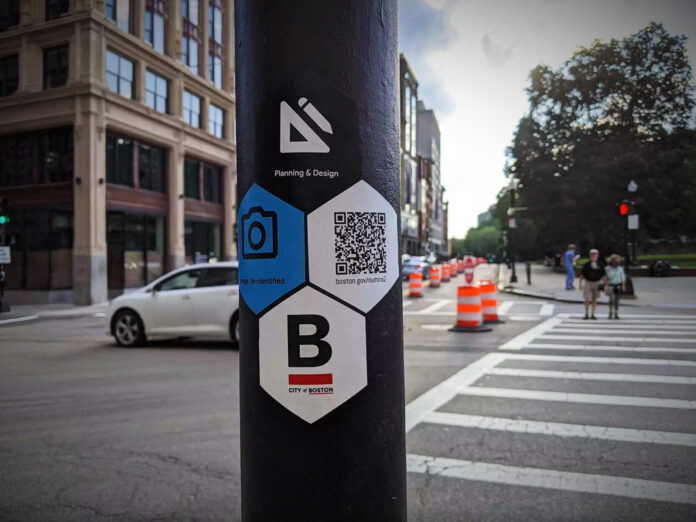It has taken three years to appear, but four cities (“communities”) are to adopt and test a set of visual icons, originally developed and announced as part of the Google parent-company Alphabet’s Sidewalk Labs project, on smart-connected infrastructure around their streets and neighbourhoods. The initiatives are mainly to build citizen trust in new urban IoT tracking and monitoring gadgetry, and particularly in surveillance and data-capture tech – which risks being, even, vandalised and removed because of a fundamental lack of public faith in smart-city tech.
The Angers-Loire metropolitan region in France, the town of Innisfil in Canada, and the cities of Boston and Washington DC in the US are to deploy the Digital Trust for Places and Routines (DTPR) iconography, designed as a “unified taxonomy and visual language” for smart cities to give techno-agency to residents and visitors, and now offered as an open source initiative.
A statement from the World Economic Forum, which is supporting the DTPR standard via its ‘global action plan’ to “strengthen global governance and innovation of IoT”, said: “DTPR is an initiative that allows the public to understand and interact with smart technologies installed in their cities. At its heart is a taxonomy of digital technologies, a set of visual icons providing visibility and awareness of the technologies installed, and a mechanism for public feedback.”
Sidewalk Labs, which was folded back into Google in 2021 after a run of bad press about privacy concerns and failed projects (notably, in Toronto), released a set of mock-up icons back in 2019 to work like food nutrition labels for emerging digital systems in public spaces. The point was to define and explain the role and accountability of digital solutions being rolled out by public and private authorities in cities, and in the broader public realm.
But the icon set has lived on in the open source DTPR project, as a way to enable anyone moving through a DTPR-badged public space with data-collecting technology to send questions and comments to the “place manager” responsible for it. Angers-Loire, Innisfil, Boston, and Washington DC are the first to sticker their smart infrastructure, and set up enquiry desks to explain about the data being collected in urban spaces.
The World Economic Forum said a “clear gap’ remains between policy and implementation of cities’ stated promises on transparency and citizen engagement. It wrote: “They are missing ready-to-use methodologies and toolsets that increase the legibility of these technologies – rendering transparency unattainable, and residents unable to meaningfully engage in dialogue about public infrastructure.”
The World Economic Forum said findings from initial DTPR research and pilots shows three ways for local governments to build public trust around new tech: by providing an explanation of city technologies; by enabling public feedback on them; and by measuring their effectiveness. Boston has tested the first concept, by placing DTPR-labelled sensors at three road intersections in the city for four weeks in 2020
Apparently, 100-odd people engaged with the Boston signage in the period. Nayeli Rodriguez, from the city’s office of urban mechanics, reflected: “While cities increasingly rely on new technologies and datasets to function and thrive, they and their partners must also take responsibility for promoting a shift in cultural awareness around technology, data and related challenges. This means investing in engaging communication tools and public processes.”
The point about public feedback has been tested by Amnesty International in New York City, working with locals to position new facial recognition tech. The World Economic Forum noted certain installations are more likely to raise hackles, and more important to consult on. “Surveillance tech can create a rift between communities, businesses and governments. [which] can potentially damage public trust,” it said.
It said a failure to engage citizens can also lead to vandalism of new tech gadgetry, and its eventual removal, even if it is designed for public safety. It said: “If local governments don’t proactively disclose details about technology they’ve implemented and the data it collects, residents will find ways to learn about what is happening in their city on their own terms.”
Meanwhile, the evaluation phase is important to prove the technology to the public, and ease the relationship further. “When smart city projects do use metrics, they often have a limited technology- or sector-specific focus, neglecting community benefits and impacts,” it said, referencing a NIST project on smart-city KPIs. “Without proper data, metrics and input, cities will have trouble managing and maintaining trust in the use of these technologies over time.”

